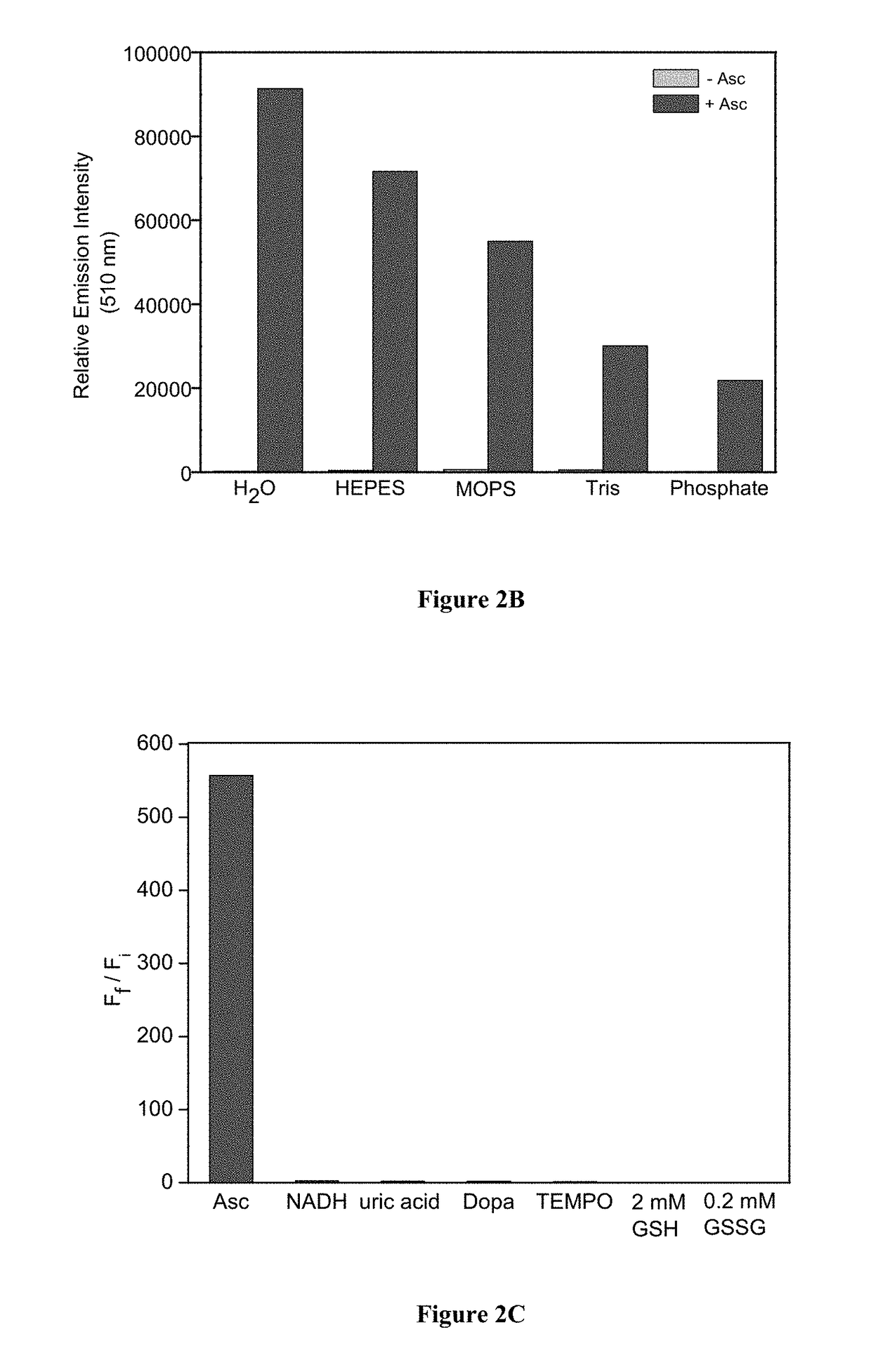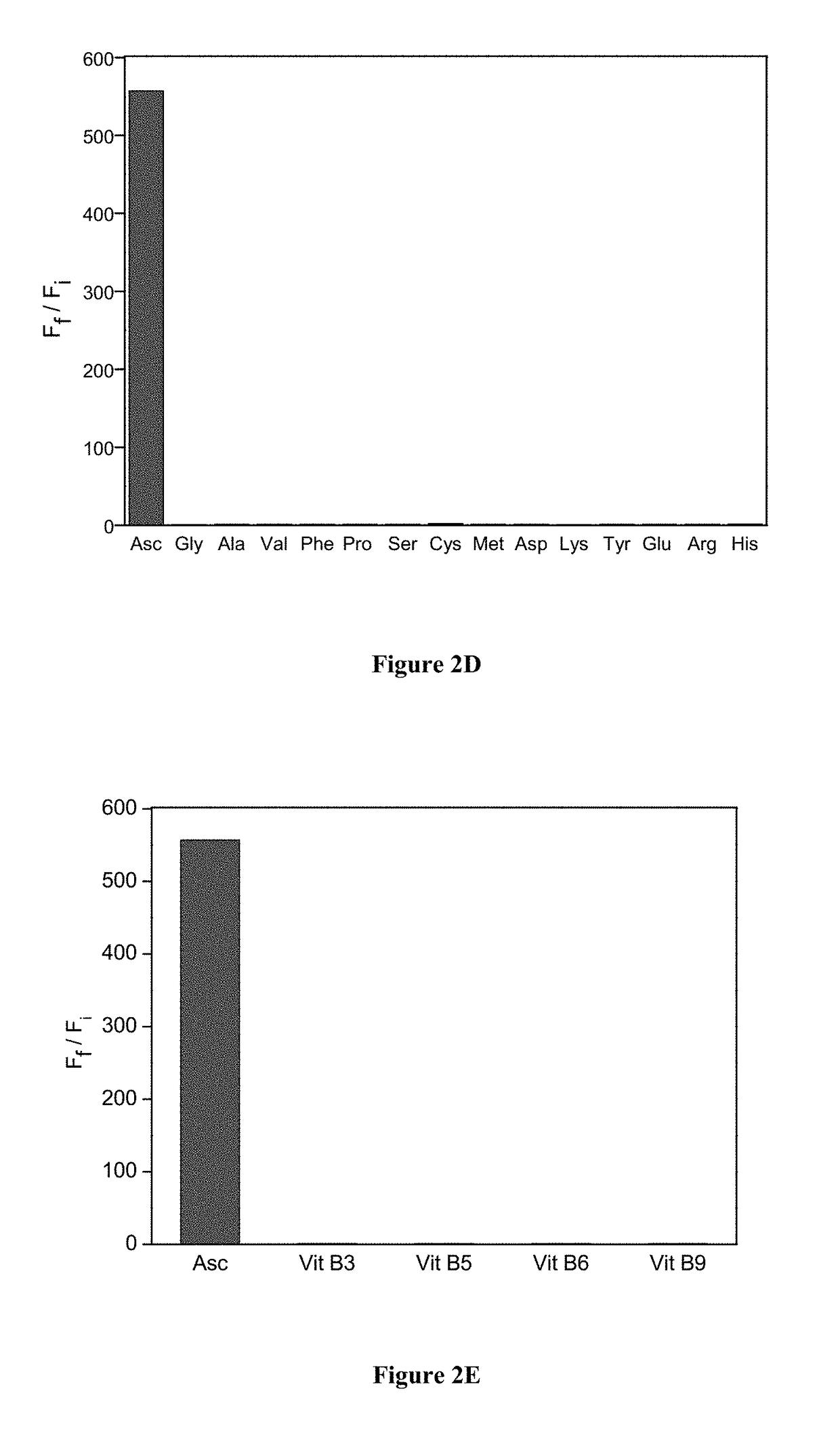Molecular probes for ascorbate detection and methods of use
- Summary
- Abstract
- Description
- Claims
- Application Information
AI Technical Summary
Benefits of technology
Problems solved by technology
Method used
Image
Examples
example 1
of Fluorescein Containing Probe AP1 (Ligand-Fluorophore Conjugate)
Materials and Methods
[0252]All solvents were of reagent grade. All commercially purchased chemicals were used as received. Ascorbic acid was purchased from Sigma-Aldrich. 2-picolylamine and benzaldehyde were purchased from AK science. 2,6-dichloromethylpyridine was synthesized according to the literature. Fluorescein derivative 1c was synthesized according to methods known in the art.
[0253]A schematic for the synthesis of AP1 ligand is shown in scheme 1 below. Scheme 1:
[0254]
[0255](i) Synthesis of 1a
[0256]A mixture of 2-picolylamine (0.41 ml, 4.0 mmol) and benzaldehyde (0.4 ml, 4.0 mmol) in 40 ml MeOH was stirred at room temperature for 2 hours. The solution was cooled in an ice bath, NaBH4 (0.3 g, 8 mmol) was added in small portions. The mixture was slowly warmed to room temperature, and stirred for 1 hour. Solvent was removed and the residue was re-dissolved in CH2Cl2, washed with saturated K2CO3 solution twice and ...
example 2
of Resorufin Containing Probe AP2 (Ligand-Fluorophore Conjugate)
Materials and Methods
[0266]All solvents were of reagent grade. All commercially purchased chemicals were used as received. Ascorbic acid was purchased from Sigma-Aldrich. 2-picolylamine and benzaldehyde were purchased from AK science. 2,6-dichloromethylpyridine was synthesized according to methods known in the art. Resorufin sodium salt was obtained from Sigma-Aldrich.
[0267]
[0268]A mixture of resorufin sodium salt (0.12 g, 0.50 mmol), compound 1b (0.17 g, 0.50 mmol), K2CO3 (0.35 g, 2.5 mmol) and KI (83 mg, 0.50 mmol) in 40 ml DMF was heated at 90° C. overnight. After cooling to room temperature, insoluble materials were removed by filtration; the filtrate was concentrated and purified by a basic alumina column (100% ethyl acetate→50:1 ethyl acetate / MeOH). The product was isolated as a dark red solid. Yield=0.12 g, 48%.
[0269](i) Generating the Ascorbate Probe (pAP2)
[0270]Ascorbate probe ligand (AP2) was dissolved in ethy...
example 3
of Coumarin Containing Probe AP3 (Ligand-Fluorophore Conjugate)
Materials and Methods
[0274]All solvents were of reagent grade. All commercially purchased chemicals were used as received. Ascorbic acid was purchased from Sigma-Aldrich. 2-picolylamine and benzaldehyde were purchased from AK science. 2,6-dichloromethylpyridine was synthesized according to methods known in the art. 7-hydroxycoumarin was obtained from J&K Scientific.
[0275]A schematic for the synthesis of the AP3 ligand is shown in Scheme 2 below. Scheme 2.
[0276]
[0277]A mixture of umbelliferone (85 mg, 0.53 mmol), compound 1b (0.18 g, 0.53 mmol), K2CO3 (0.37 g, 2.7 mmol) and KI (88 mg, 0.53 mmol) in 40 ml DMF was heated at 90° C. overnight. After cooling to room temperature, insoluble materials were removed by filtration, the filtrate was concentrated and purified by a basic alumina column (100% ethyl acetate). The product was isolated as a pale yellow solid. Yield=0.21 g, 84%.
[0278]Generating the Ascorbate Probe (pAP3)
[02...
PUM
 Login to View More
Login to View More Abstract
Description
Claims
Application Information
 Login to View More
Login to View More - R&D
- Intellectual Property
- Life Sciences
- Materials
- Tech Scout
- Unparalleled Data Quality
- Higher Quality Content
- 60% Fewer Hallucinations
Browse by: Latest US Patents, China's latest patents, Technical Efficacy Thesaurus, Application Domain, Technology Topic, Popular Technical Reports.
© 2025 PatSnap. All rights reserved.Legal|Privacy policy|Modern Slavery Act Transparency Statement|Sitemap|About US| Contact US: help@patsnap.com



